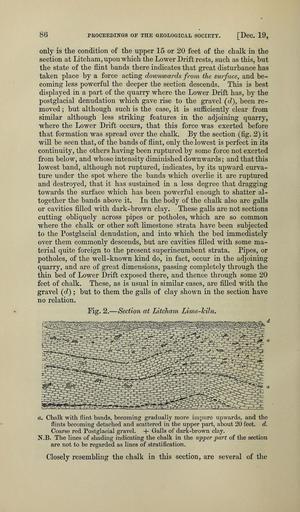MAKE A MEME
View Large Image

| View Original: | The_Quarterly_journal_of_the_Geological_Society_of_London_(13070924955).jpg (1211x2069) | |||
| Download: | Original | Medium | Small | Thumb |
| Courtesy of: | commons.wikimedia.org | More Like This | ||
| Keywords: The Quarterly journal of the Geological Society of London (13070924955).jpg 86 <br> PROCEEDINGS OF THE GEOLOGICAL SOCIETY DcC 19 <br> only is the condition of the upper 15 or 20 feet of the chalk in the <br> section at Litcham upon which the Lower Drift rests such as this hut <br> the state of the flint bands there indicates that great disturbance has <br> taken place by a force acting downwards from the surface and be- <br> coming less powerful the deeper the section descends This is best <br> displayed in a part of the quarry where the Lower Drift has by the <br> postglacial denudation which gave rise to the gravel d been re- <br> moved ; but although such is the case it is sufficiently clear from <br> similar although less striking features in the adjoining quarry <br> where the Lower Drift occurs that this force was exerted before <br> that formation was spread over the chalk By the section fig 2 it <br> will be seen that of the bands of flint ovlj the lowest is perfect in its <br> continuity the others having been ruptui ed by some force not exerted <br> from below and whose intensity diminished downwards; and that this <br> lowest band although not ruptured indicates by its upward curva- <br> ture under the spot where the bands which overlie it are ruptured <br> and destroyed that it has sustained in a less degree that dragging <br> towards the surface which has been powerful enough to shatter al- <br> together the bands above it In the body of the chalk also are galls <br> or cavities filled with dark-brown clay These galls are not sections <br> cutting obliquely across pipes or potholes which are so common <br> where the chalk or other soft limestone strata have been subjected <br> to the Postglacial denudation and into which the bed immediately <br> over them commonly descends but are cavities filled with some ma- <br> terial quite foreign to the present superincumbent strata Pipes or <br> potholes of the well-known kind do in fact occur in the adjoining <br> quarry and are of great dimensions passing completely through the <br> thin bed of Lower Drift exposed there and thence through some 20 <br> feet of chalk These as is usual in similar cases are filled with the <br> gravel d ; but to them the galls of clay shown in the section have <br> no relation <br> Fig 2 ” Section at Litcham Lime-Jciln <br> a Chalk with flint bands becoming gradually more impure upwards and the <br> flints becoming detached and scattered in the upper part about 20 feet d <br> Coarse red Postglacial gravel + Grails of dark -brown clay <br> N B The lines of shading indicating the chalk in the upper part of the section <br> are not to be regarded as lines of stratification <br> Closely resembling the chalk in this section are several of the 36344813 112028 51125 Page 86 Text v 23 http //www biodiversitylibrary org/page/36344813 1867 Geological Society of London Biodiversity Heritage Library The Quarterly journal of the Geological Society of London v 23 1867 Geology Periodicals Smithsonian Libraries bhl page 36344813 dc identifier http //biodiversitylibrary org/page/36344813 smithsonian libraries Information field Flickr posted date ISOdate 2014-03-10 Check categories 2015 August 26 CC-BY-2 0 BioDivLibrary https //flickr com/photos/61021753 N02/13070924955 2015-08-26 14 51 54 cc-by-2 0 PD-old-70-1923 The Quarterly journal of the Geological Society of London 1867 The Quarterly journal of the Geological Society of London 1867 Photos uploaded from Flickr by Fæ using a script | ||||